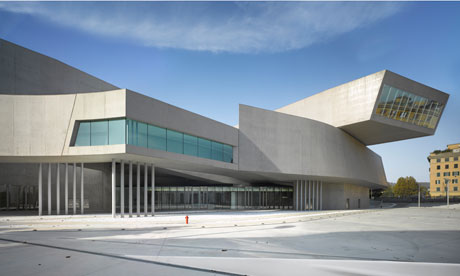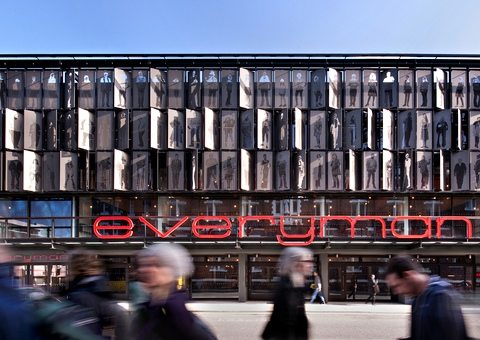It has been murmured for a very long time, and argued, and shouted, that there might be limitations to the idea of iconic buildings, the notion that architectural inspiration begins and ends with the extravagant flourishes of a quasi-celebrity. You could guess, even as the last fireworks were fizzling out at the grand opening of the icon of iconic buildings, the Bilbao Guggenheim, that no matter what its beauties here was a precedent that would be overworked. This was in 1997.
Now, finally, the Stirling prize has come up with a shortlist that is firmly un-iconic, having inched close to such a thing last year. There's a chapel, a visitor's centre, some housing in Harlow, a refurbished ex-council estate, a ruined castle converted into an attractive holiday let, and, from the University of Limerick, a project described as a medical school, student housing and bus shelter. The architects are known and respected in the business, but they are not stars. After years in which the prize has favoured the spectacular, and the heirs of what was once called hi-tech, it's a welcome corrective. Unfortunately it has come at the cost of excluding two buildings, by Zaha Hadid and the late Jan Kaplicky, that should be there.
The virtues of each of those included are thoughtfulness, craft, the application of intelligence to difficult and sensitive issues, which – lest these sound like polysyllabic synonyms for dull – also lift the spirits. There is nothing from the great Olympic city of London, that island of recession-proof architectural glitter. There is an Irish tinge, with one project in the Republic, one in the north, and one by an Irish-born Londoner. Apart from the refurbished estate, there is nothing above four storeys. (The Shard, it should be noted, was not entered, but is likely to appear next year.)
As the RIBA point out, half the shortlisted practices are led by women, which should be no big deal except that, in a still absurdly male business, it hasn't happened before. The question of gender carries extra resonance this year, as there is a vigorous campaign on behalf of the American architect Denise Scott Brown, who should have shared the 1991 Pritzker prize with her husband and collaborator Robert Venturi, but was left out.
In the past the Stirling prize has been prone to crushes on the mighty. Once it was Norman Foster, then Richard Rogers, then Hadid, with eyelashes also fluttered in the direction of David Chipperfield. This year the temptation was resisted (which would not have been hard) to recognise Rogers's silo for oligarchs, the luxury housing development of One Hyde Park. Foster barely flickered on the radar.
The judges' anti-iconic zeal also led them to omit Hadid's Pierresvives building in Montpellier, which is a shame, as it is magnificent, and better than the two projects with which she previously won the Stirling. For it's a point sometimes lost on anti-iconists that it is possible to have good as well as bad iconic buildings. Inclusion of Pierresvives (which houses the archive, library and sports department of the local government) could also have created a vertiginous, scarcely believable female majority, but that will have to wait for another year.
Also left out is the last work of Jan Kaplicky, founder of the practice Future Systems, and perennially frustrated seer of a technological architecture that never precisely arrived. This building, the Enzo Ferrari museum in Modena, is curvy, yellow on the outside, white on the inside and, despite the fact that this description could apply to a banana, gracious and accomplished. It should have been on the list too.
Instead the Stirling offers a version of the British Isles where architecture is above all well made and subtle, and at one with both nature and history. Niall McLaughlin's Bishop Edward King chapel, for example, sits comfortably amid Cotswolds scenery and gothic revival architecture while also achieving levels of workmanship that might have been thought extinct. Witherford Watson Mann's Astley Castle makes a ruin habitable (as a Landmark Trust holiday home) with a considered, but still bold, fusion of old and new.
Something similar is done at Park Hill, Sheffield, by Hawkins/Brown and Studio Egret West, with the difference here that the old building is a mighty 1960s council estate, now a listed building, rather than an 800-year-old castle. As at Astley, the architects have shown some nerve with the extent of their additions and alterations, but have pulled it off. To appreciate the architecture fully, however, you have to ignore its part in Sheffield's policy of reducing its stock of council housing.
The most sober project is Grafton Architects' medical school in Limerick, where the ultimate objects are not the individual buildings, but the places they combine to make. The liveliest is Heneghan Peng's visitor centre for the Giant's Causeway in Antrim, where an artificial geology of stone columns and sloping planes is created. I have some trouble with the idea of creating artificial geology here, where the actual geology of the Giant's Causeway itself is exceptional and unimprovable, but there's something lovely going on with both changes of level and the massiveness of the masonry.
Finally there's Alison Brooks's Newhall in Harlow, a determined attempt on one of the most difficult tasks in architecture, the reinvention of the standard developers' house. It succeeds, with skilful use of siting, open space, internal planning and roof space, even if a liking for the colour black is a prerequisite for living here. Brooks has previously won a Stirling prize, as part of the team that designed the 2008 winner, the Accordia housing development in Cambridge. It might be thought repetitive to award her again, except that it's a very different proposition to design relatively cheap housing in Harlow, compared with a well-heeled development in Cambridge.
It's good that the Stirling prize is recognising the quieter qualities of these buildings, and the RIBA regional awards, from which the shortlist derives, include a good many more with similar virtues. It suggests that there are alternatives to the march of gaudy aluminium cladding, which is the standard form of contemporary construction.
It means that this year's prize is about architecture, about the realisation of a concept in space, structure and detail, whereas it has sometimes been about making a point about the design of schools, or compensating a leading architect previously overlooked. In which case the winner should be McLaughlin's chapel: it may now be a rarefied building type, without much to contribute to the problems of contemporary cities, but as an example of the design of buildings, it's the best.
The winner of the 2013 RIBA Stirling prize will be announced on 26 September. On 10 September Rowan Moore will chair a discussion at the RIBA, London W1 with the six shortlisted architects. Tickets are £10 to Guardian Extra members (guardian.co.uk/extra)











